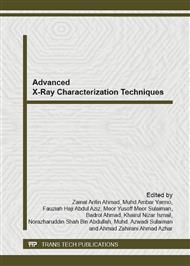p.340
p.345
p.350
p.356
p.362
p.368
p.373
p.378
p.384
Compressive and Wear Resistance of Alumina Reinforced Fe-Cr Matrix Composites
Abstract:
Fe-Cr matrix composite reinforced with alumina with mean powder sizes of 13, 23, 24 and 64 μm was successfully obtained through powder metallurgy method. The powder mixture were blended at a rotating speed of 250 rpm for thirty minutes and uni-axially pressed at a pressure of 750 MPa. Samples identified as J13, J23, J24 and J64 according to alumina particles size were sintered in a vacuum furnace under 10-2 Torr at a temperature of 1100°C for two hours with 10°C/minutes heating rate. The peaks of XRD patterns have been identified as belonging to the phases of Fe, Cr and alumina. The EDX analysis confirms the existence of Fe, Cr, Al and O. Reinforcing the Fe-Cr matrix with alumina particles bigger than 13 µm deteriorated the microstructure and mechanical properties of the composites. The wear coefficient for sample reinforced with 13 µm alumina particles is 2.46 × 10-11 with compressive strength of 278 MPa. Meanwhile for sample reinforced with 64 µm alumina particles its wear coefficient is 5.09 × 10-11 and compressive strength is 81 MPa. It is found that reinforcing smaller alumina particles sizes to Fe-Cr matrix resulted in better wear and strength properties of the composites.
Info:
Periodical:
Pages:
362-367
Citation:
Online since:
December 2012
Keywords:
Price:
Сopyright:
© 2013 Trans Tech Publications Ltd. All Rights Reserved
Share:
Citation:


